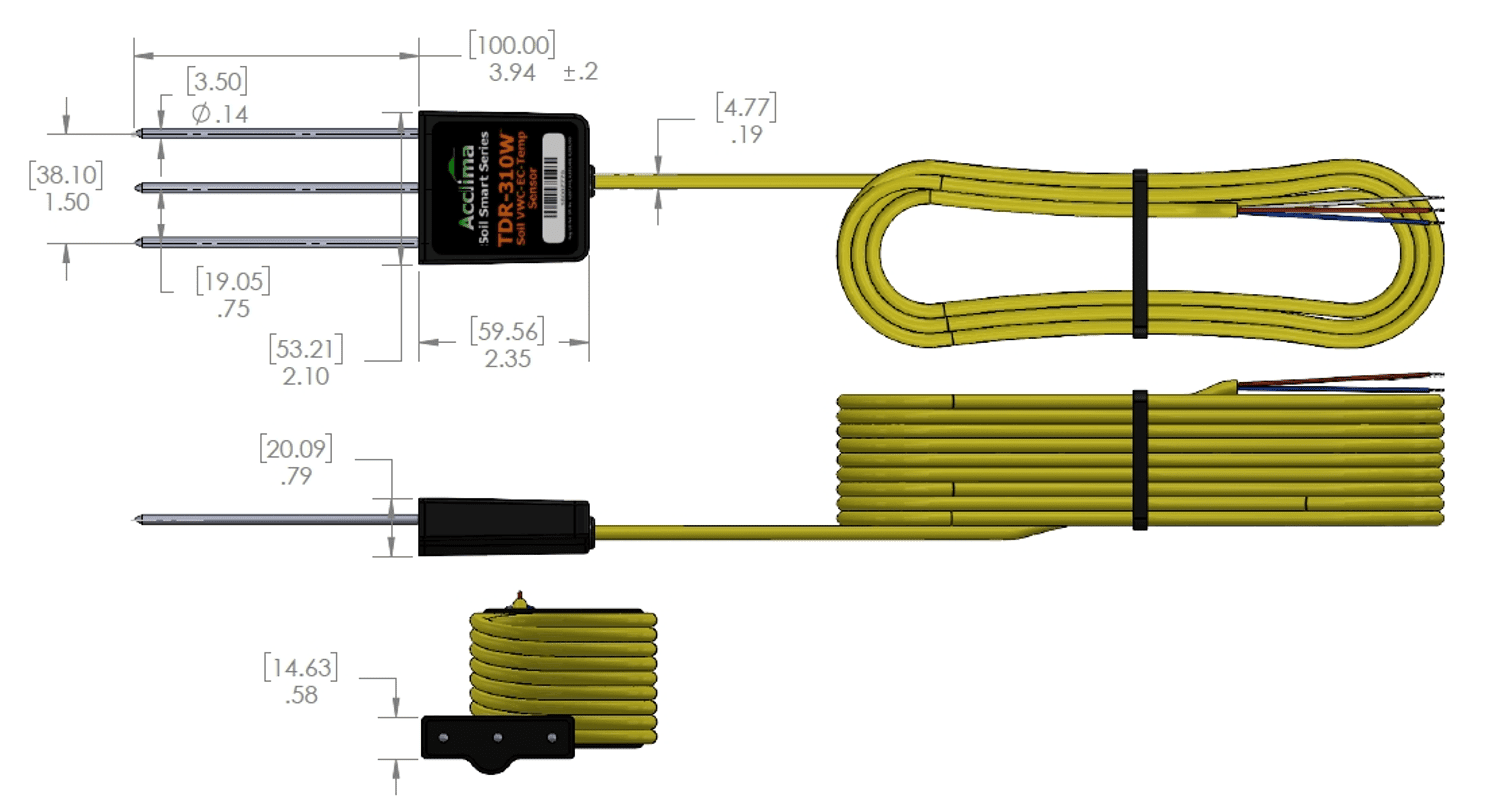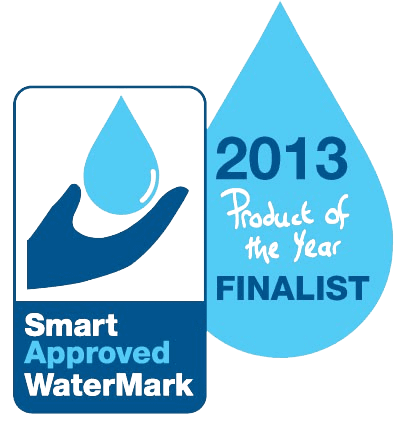November 20, 2022

The TDR-310W is a modification to the Acclima TDR-315N. Its shorter rods (10cm instead of 15cm) allow it to fit in standard rockwool blocks. The Soil Smart analysis engine is also tuned for non-mineral soils often used in Controlled Environment Agriculture (CEA), such as rockwool and coco coir, yet still performs well in traditional mineral soils. It also has a much higher amplitude waveform than the H-series sensors, which consumes more power, but makes it very effective in taking measurements in challenging soil environments. It is a complete integrated time domain reflectometer that combines ultra-fast waveform generating and digitizing functions with a precision 5 pico-second resolution time base and highly sophisticated waveform digitizing and analyzing firmware that provides true time domain analysis of soil-propagated waveforms.
Its form factor is designed primarily for ease-of-use in non-mineral media commonly used in vertical farming applications. A probe guide is provided to ensure that the waveguide rods are parallel when pushing them into the soil. It provides reading data through a 3-wire SDI-12 interface and is compatible with any data recorder that is compliant with SDI-12 version 1.4 and earlier.
Its form factor is designed primarily for ease-of-use in non-mineral media commonly used in vertical farming applications.
| Parameter | Min | Max | Units |
| RELATIVE PERMITTIVITY | |||
| Range | 1 | 100 | – |
| Resolution | 0.1 | – | |
| Repeatability (RMS deviation) | 0.14 | – | |
| Accuracy | -2 | +2 | %FS[1] |
| Stability with Bulk Electrical Conductivity (0-3000 uS/cm) | -1 | +1 | %FS |
| VOLUMETRIC WATER CONTENT (VWC) | |||
| Range[2] | 0 | 100 | % |
| Resolution | 0.1 | % | |
| Repeatability (RMS deviation) | 0.3 | % | |
| Accuracy | -2.5 | +2.5 | %FS |
| Stability with Bulk Electrical Conductivity (0-4500 uS/cm) | -1 | +1 | %FS |
| TEMPERATURE[3] | |||
| Range | -40 | +55 | °C |
| Resolution | 0.1 | °C | |
| Repeatability (RMS deviation) | 0.01 | °C | |
| Accuracy (+5 to +35 °C) | -0.25 | +0.25 | °C |
| Accuracy (-15 to +55 °C) | -0.5 | +0.5 | °C |
| BULK ELECTRICAL CONDUCTIVITY (BEC) | |||
| Range | 0 | 4500 | uS/cm |
| Resolution | 1 | uS/cm | |
| Repeatability (RMS deviation) | 3 | uS/cm | |
| Accuracy (0 – 1000 uS/cm) | -25 | +25 | uS/cm |
| Accuracy (1000 – 2500 uS/cm) | -2.5 | +2.5 | % |
| Accuracy (2500 – 4500 uS/cm) | -5 | +5 | % |
[1] Percent Full scale, i.e., +/- 2 percentage points.
[2] VWC is calculated based on relative permittivity using the formula derived by Topp with minor modifications toallow readings in slurries and pure water. The relative permittivity of water varies with temperature, so to see a reading near 100%, the sensor must be fully immersed in water long enough to equilibrate temperature with the water. The water should be at 20.5C with at least 4cm of water around the rods on all sides, beyond the tips of the
rods, and at least 1cm of the sensor body immersed. VWC readings higher than 100% are possible when the permittivity is higher than 80.
[3] The temperature sensing element is located next to one of the outer waveguide electrodes.
Stresses beyond those specified below may cause permanent damage to the sensor. These are stress ratings only and operation at these levels is not implied.
| Parameter | Min | Max | Units |
| Supply Voltage (Measured between the red and white wires) | -16 | +16 | Volts |
| SDI-12 Data Voltage (Blue-White wires) | -16 | +16 | Volts |
| External Voltage Applied to sensor rod | -0.3 | +4 | Volts |
| Electrostatic discharge, center rod | IEC 61000−4−2 (ESD) | ||
| Storage Temperature | -40 | +60 | °C |
| -40 | +140 | °F | |
| Parameter | Min | Max | Units |
| Operating Supply Voltage (Prior to 2H 2022) | +3.5 (+6.5) | +15 | Volts |
| Operating Temperature (VWC errors due to ice) | -30 | +55 | °C |
| Operating Temperature (VWC accurate, no ice allowed) | 0 | +55 | °C |
| POWER CONSUMPTION | |||
| Idle Current (sensor powered but inactive, 20 °C) | < 10 | uA | |
| Idle Current (-35 to +50 °C) | < 50 | uA | |
| Sensor read time | 0.4 typical | sec | |
| Sensor read current (Supply Voltage = 12V) | 118 typical | mA | |
| Sensor read current (Supply Voltage = 7V) | 150 typical | mA | |
| Sensor communications current | 6 typical | mA | |
| Parameter | Min | Max | Units |
| INPUT (when sensor is idle or receiving data) | |||
| Resistance to GND | 160k | 175k | Ohms |
| VIL (required input voltage in “marking” state) | -1 | 1.3 | V |
| VIH (required input voltage in “spacing” state) | 3.2 | 6 | V |
| OUTPUT (when sensor is transmitting data) | |||
| Output impedance | 1000 | 1250 | Ohms |
| VOL (output voltage in “marking” state) | 0 | 0.25 | V |
| VOH (output voltage in “spacing” state) | 4.7 | 5.2 | V |
| Dimensions (without cable) | 16 cm x 5.3 cm x 2 cm |
| Weight (without cable) | 94 g |
| Cable weight | 32.7 g/m |
| Composition | 316 Stainless Steel, Epoxy, ABS Plastic |
| Cable | 3 copper conductor, 22 Ga., waterproof and UV resistant PVC jacket, 4.8mm overall diameter |
| Communication Protocol | SDI-12 Version 1.4 |




Copyright Acclima ©, Inc. All rights reserved.